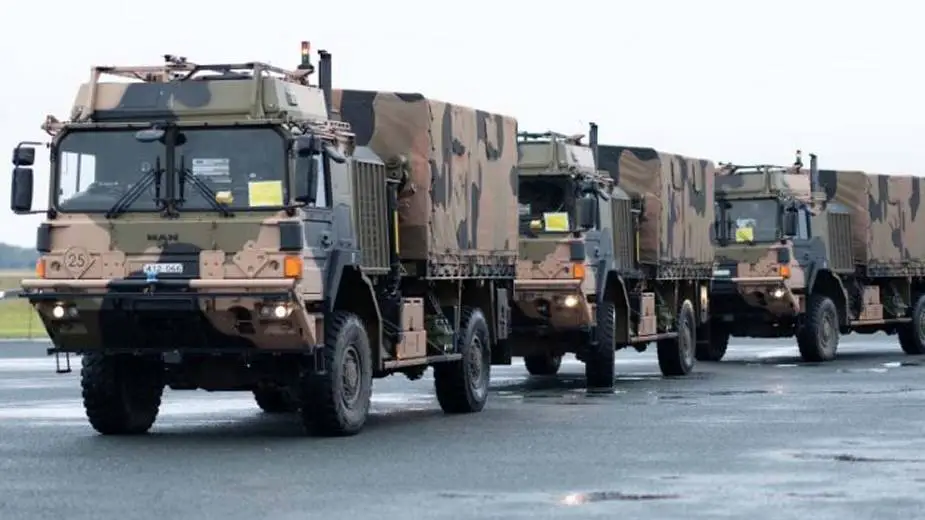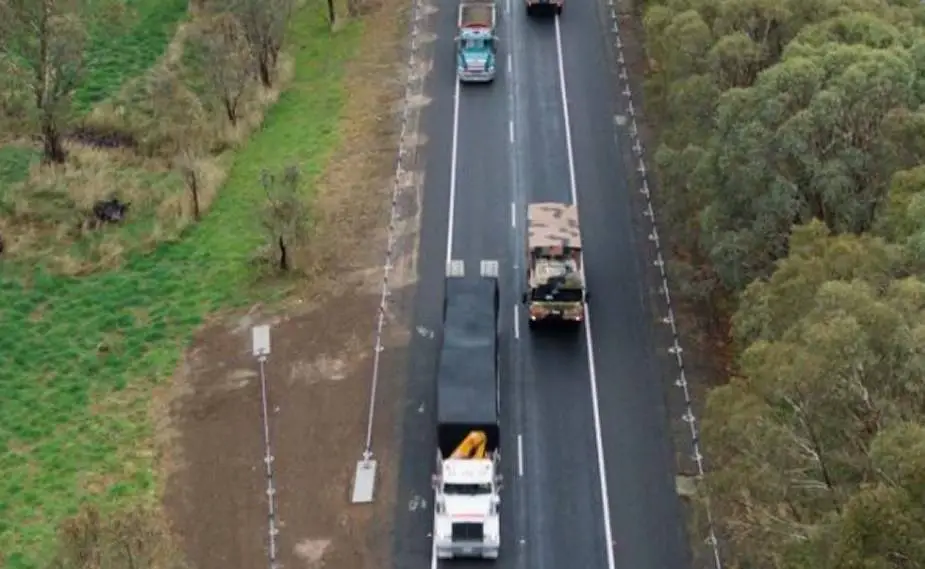Breaking news
Australian Army successfully tests autonomous truck convoy.
The Australian Army reports that it successfully operated an autonomous truck convoy on a public road in Australia for the first time on June 6. The National Transport Research Organisation and Deakin University supported the leader-follower trial, in which a convoy of four autonomous Army trucks followed a crewed ‘leader’ vehicle on a public road in Victoria.
Follow Army Recognition on Google News at this link

Colonel Robin Smith, of the Army’s Future Land Warfare Branch, said the autonomous vehicles performed well: “This trial showed how a convoy could undertake a resupply mission between an airfield and a military base, giving us an idea of how this kind of technology could be used in the future“ (Picture source: Australian army)
Colonel Robin Smith, of the Army’s Future Land Warfare Branch, said the autonomous vehicles performed well: “This trial showed how a convoy could undertake a resupply mission between an airfield and a military base, giving us an idea of how this kind of technology could be used in the future. Driving on a highway in traffic meant the technology was tested to stop safely and leave distances between other vehicles, while following the path set by the leader. Down the track, technology like this could remove our soldiers from dangerous environments, or help free soldiers up for other roles.”
During the highway trials, Army simulated an autonomous resupply mission between Mangalore Airfield and Puckapunyal using the Goulburn Valley Highway and the Hume Highway.
The trial is part of Army’s modernisation, which includes exploring human-machine teaming, quantum technology, artificial intelligence and electrification. Army continues to collaborate with industry and academia to explore how technology can increase mission success and lower risk to soldiers.

Driving on a highway in traffic meant the technology was tested to stop safely and leave distances between other vehicles, while following the path set by the leader (Picture source: Australian army)
Advantages of autnomous convoys powered by AI and robotics
In recent years, the rapid advancement of technology has paved the way for groundbreaking innovations across various industries. One such area of transformation is the military, where autonomous technologies are reshaping traditional practices. Autonomous convoys, powered by artificial intelligence (AI) and robotics, are emerging as a game-changer in military logistics. These unmanned vehicle formations offer several significant advantages to modern armies, ranging from enhanced safety and efficiency to improved strategic capabilities. Hereunder are listed some benefits that autonomous convoys bring to the military and their potential to revolutionize warfare.
Increased operational safety
Safety is a paramount concern in military operations. By deploying autonomous convoys, the army can reduce the risk to human lives involved in transportation and logistics. Removing soldiers from the driver's seat eliminates the dangers associated with long convoys, fatigue-related accidents, and roadside attacks. These autonomous vehicles, equipped with advanced sensors and AI algorithms, can effectively detect obstacles, monitor road conditions, and respond to potential threats with split-second precision. With enhanced situational awareness and adaptive decision-making capabilities, autonomous convoys minimize the likelihood of human error, improving the overall safety of military operations.
Enhanced efficiency and resource optimization
Logistical operations form the backbone of any military campaign. Autonomous convoys can significantly optimize these operations by enhancing efficiency and resource allocation. With self-driving vehicles, convoy movements can be synchronized and choreographed, ensuring seamless coordination and reducing convoy intervals. This optimization leads to increased troop mobility, faster response times, and the ability to swiftly transport essential supplies, equipment, and ammunition to the frontlines. By minimizing delays and human-related inefficiencies, autonomous convoys free up valuable manpower, allowing soldiers to focus on more critical tasks.
Reduced operational costs
Military operations require substantial financial resources. Autonomous convoys have the potential to reduce operational costs in multiple ways. Firstly, the elimination of human drivers lowers personnel expenses associated with training, salaries, and benefits. Secondly, the improved fuel efficiency achieved through optimized routing and constant speed control can result in significant savings on fuel costs. Additionally, the reduced likelihood of accidents, damages, and insurance claims further decreases financial burdens. By streamlining logistical processes, autonomous convoys offer a cost-effective solution for military transportation needs.
Enhanced strategic capabilities
Autonomous convoys introduce new strategic possibilities for military commanders. The advanced AI algorithms powering these vehicles can analyze vast amounts of data in real-time, enabling quick adaptation to changing scenarios and dynamic battlefield conditions. Autonomous systems can coordinate and communicate with each other, forming cohesive and intelligent formations that can react and adjust to emerging threats on the battlefield. Moreover, the ability to integrate autonomous convoys with other military assets, such as drones and reconnaissance systems, enhances intelligence gathering, surveillance, and reconnaissance capabilities. This integration results in improved situational awareness, rapid response times, and increased overall operational effectiveness.
Adaptability to various environments
One significant advantage of autonomous convoys is their adaptability to diverse operational environments. Whether it's rugged terrains, extreme weather conditions, or inhospitable landscapes, these self-driving vehicles can navigate through challenging surroundings with remarkable precision. By leveraging advanced sensor technologies like LiDAR, radar, and cameras, autonomous convoys can detect and respond to obstacles, ensuring safe and efficient transportation in even the most demanding situations. This adaptability enables military forces to operate in diverse theaters of operations, enhancing their reach and flexibility.
Defense News June 2023




























